Analysis of Supply Chain Issues and Strategies for Improvement
VerifiedAdded on 2023/02/06
|7
|1685
|39
Report
AI Summary
This report provides a detailed overview of supply chain management, addressing critical challenges faced by businesses in delivering goods and services to consumers. It identifies key issues such as material shortages, lack of supply chain visibility, demand forecasting complexity, fragmented supply chains, congestion at critical ports, and increasing freight and transportation costs. The report delves into the causes of these challenges, offering practical solutions like diversifying manufacturing supplies, improving supply chain visibility through technology, simplifying demand forecasting, addressing supply chain fragmentation through data management, finding new vendors to reduce port congestion, and cutting transportation costs through consolidation and domestic sourcing. Furthermore, it emphasizes the importance of optimizing inventory management, improving distribution networks, leveraging technology, building strong supplier relationships, regularly reviewing procedures, and establishing a supply chain council to enhance overall efficiency and sustainability. The report concludes that effective supply chain management is crucial for a company's competitive advantage and risk mitigation, emphasizing the need for continuous adaptation and improvement in this evolving field.
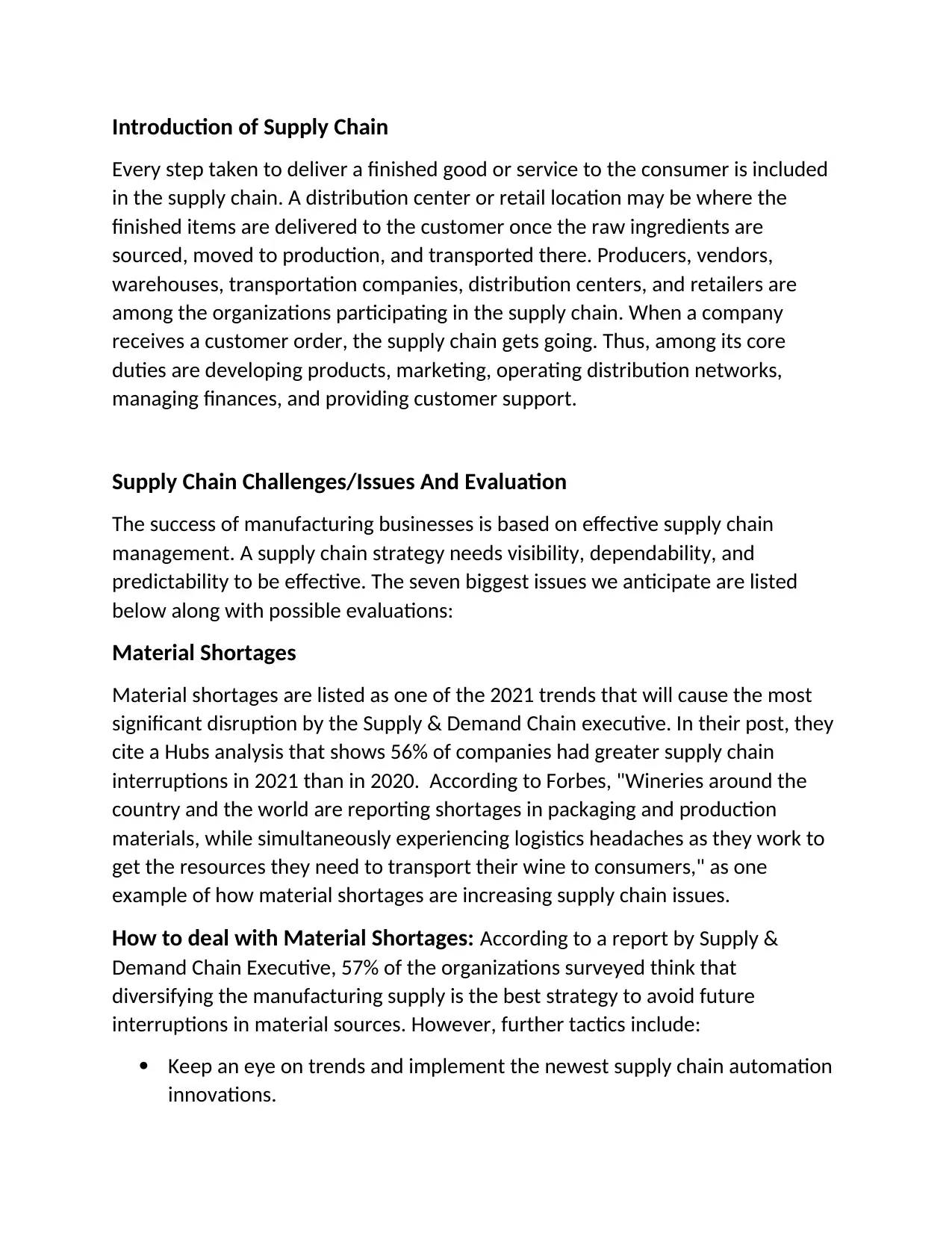
Introduction of Supply Chain
Every step taken to deliver a finished good or service to the consumer is included
in the supply chain. A distribution center or retail location may be where the
finished items are delivered to the customer once the raw ingredients are
sourced, moved to production, and transported there. Producers, vendors,
warehouses, transportation companies, distribution centers, and retailers are
among the organizations participating in the supply chain. When a company
receives a customer order, the supply chain gets going. Thus, among its core
duties are developing products, marketing, operating distribution networks,
managing finances, and providing customer support.
Supply Chain Challenges/Issues And Evaluation
The success of manufacturing businesses is based on effective supply chain
management. A supply chain strategy needs visibility, dependability, and
predictability to be effective. The seven biggest issues we anticipate are listed
below along with possible evaluations:
Material Shortages
Material shortages are listed as one of the 2021 trends that will cause the most
significant disruption by the Supply & Demand Chain executive. In their post, they
cite a Hubs analysis that shows 56% of companies had greater supply chain
interruptions in 2021 than in 2020. According to Forbes, "Wineries around the
country and the world are reporting shortages in packaging and production
materials, while simultaneously experiencing logistics headaches as they work to
get the resources they need to transport their wine to consumers," as one
example of how material shortages are increasing supply chain issues.
How to deal with Material Shortages: According to a report by Supply &
Demand Chain Executive, 57% of the organizations surveyed think that
diversifying the manufacturing supply is the best strategy to avoid future
interruptions in material sources. However, further tactics include:
Keep an eye on trends and implement the newest supply chain automation
innovations.
Every step taken to deliver a finished good or service to the consumer is included
in the supply chain. A distribution center or retail location may be where the
finished items are delivered to the customer once the raw ingredients are
sourced, moved to production, and transported there. Producers, vendors,
warehouses, transportation companies, distribution centers, and retailers are
among the organizations participating in the supply chain. When a company
receives a customer order, the supply chain gets going. Thus, among its core
duties are developing products, marketing, operating distribution networks,
managing finances, and providing customer support.
Supply Chain Challenges/Issues And Evaluation
The success of manufacturing businesses is based on effective supply chain
management. A supply chain strategy needs visibility, dependability, and
predictability to be effective. The seven biggest issues we anticipate are listed
below along with possible evaluations:
Material Shortages
Material shortages are listed as one of the 2021 trends that will cause the most
significant disruption by the Supply & Demand Chain executive. In their post, they
cite a Hubs analysis that shows 56% of companies had greater supply chain
interruptions in 2021 than in 2020. According to Forbes, "Wineries around the
country and the world are reporting shortages in packaging and production
materials, while simultaneously experiencing logistics headaches as they work to
get the resources they need to transport their wine to consumers," as one
example of how material shortages are increasing supply chain issues.
How to deal with Material Shortages: According to a report by Supply &
Demand Chain Executive, 57% of the organizations surveyed think that
diversifying the manufacturing supply is the best strategy to avoid future
interruptions in material sources. However, further tactics include:
Keep an eye on trends and implement the newest supply chain automation
innovations.
Paraphrase This Document
Need a fresh take? Get an instant paraphrase of this document with our AI Paraphraser
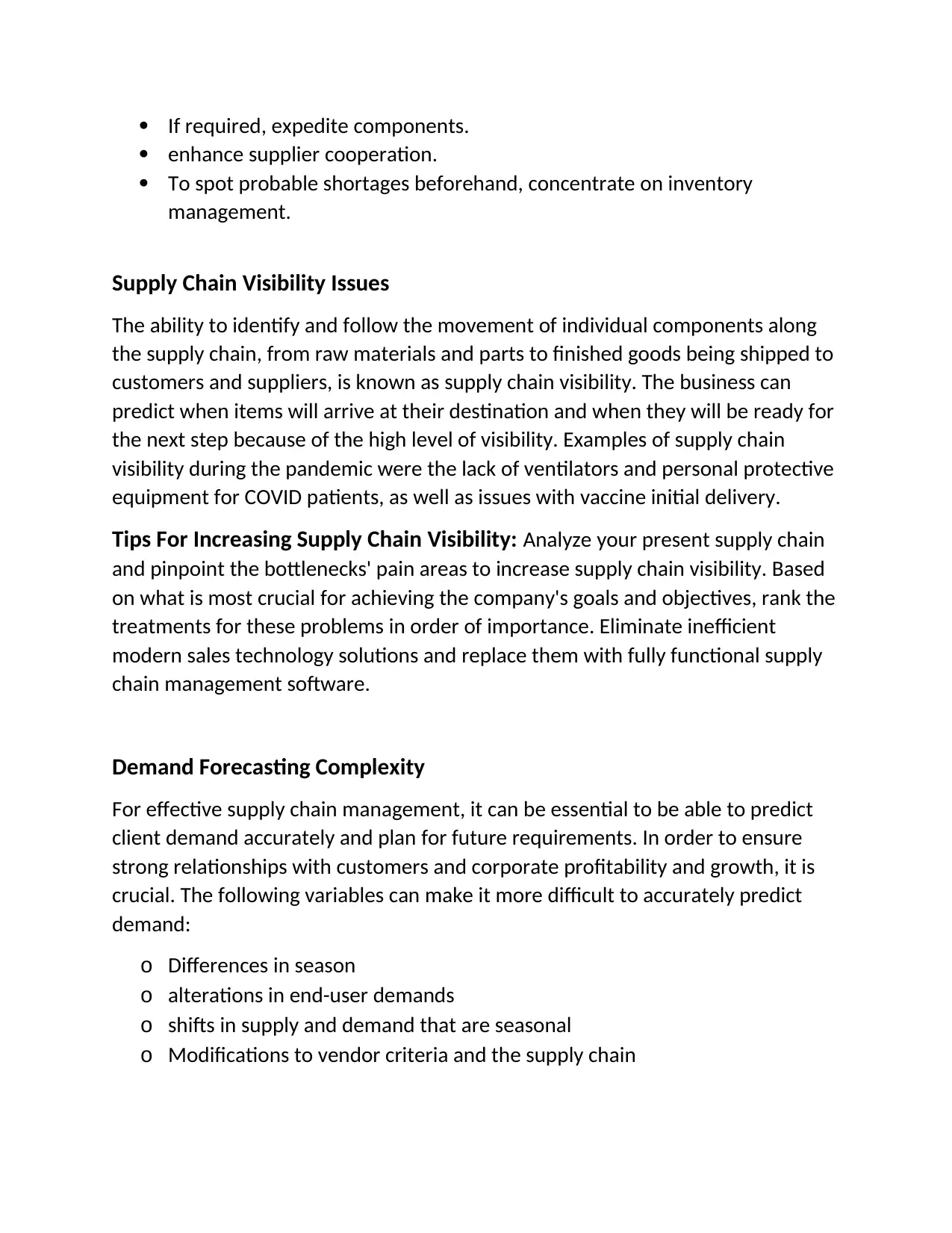
If required, expedite components.
enhance supplier cooperation.
To spot probable shortages beforehand, concentrate on inventory
management.
Supply Chain Visibility Issues
The ability to identify and follow the movement of individual components along
the supply chain, from raw materials and parts to finished goods being shipped to
customers and suppliers, is known as supply chain visibility. The business can
predict when items will arrive at their destination and when they will be ready for
the next step because of the high level of visibility. Examples of supply chain
visibility during the pandemic were the lack of ventilators and personal protective
equipment for COVID patients, as well as issues with vaccine initial delivery.
Tips For Increasing Supply Chain Visibility: Analyze your present supply chain
and pinpoint the bottlenecks' pain areas to increase supply chain visibility. Based
on what is most crucial for achieving the company's goals and objectives, rank the
treatments for these problems in order of importance. Eliminate inefficient
modern sales technology solutions and replace them with fully functional supply
chain management software.
Demand Forecasting Complexity
For effective supply chain management, it can be essential to be able to predict
client demand accurately and plan for future requirements. In order to ensure
strong relationships with customers and corporate profitability and growth, it is
crucial. The following variables can make it more difficult to accurately predict
demand:
o Differences in season
o alterations in end-user demands
o shifts in supply and demand that are seasonal
o Modifications to vendor criteria and the supply chain
enhance supplier cooperation.
To spot probable shortages beforehand, concentrate on inventory
management.
Supply Chain Visibility Issues
The ability to identify and follow the movement of individual components along
the supply chain, from raw materials and parts to finished goods being shipped to
customers and suppliers, is known as supply chain visibility. The business can
predict when items will arrive at their destination and when they will be ready for
the next step because of the high level of visibility. Examples of supply chain
visibility during the pandemic were the lack of ventilators and personal protective
equipment for COVID patients, as well as issues with vaccine initial delivery.
Tips For Increasing Supply Chain Visibility: Analyze your present supply chain
and pinpoint the bottlenecks' pain areas to increase supply chain visibility. Based
on what is most crucial for achieving the company's goals and objectives, rank the
treatments for these problems in order of importance. Eliminate inefficient
modern sales technology solutions and replace them with fully functional supply
chain management software.
Demand Forecasting Complexity
For effective supply chain management, it can be essential to be able to predict
client demand accurately and plan for future requirements. In order to ensure
strong relationships with customers and corporate profitability and growth, it is
crucial. The following variables can make it more difficult to accurately predict
demand:
o Differences in season
o alterations in end-user demands
o shifts in supply and demand that are seasonal
o Modifications to vendor criteria and the supply chain
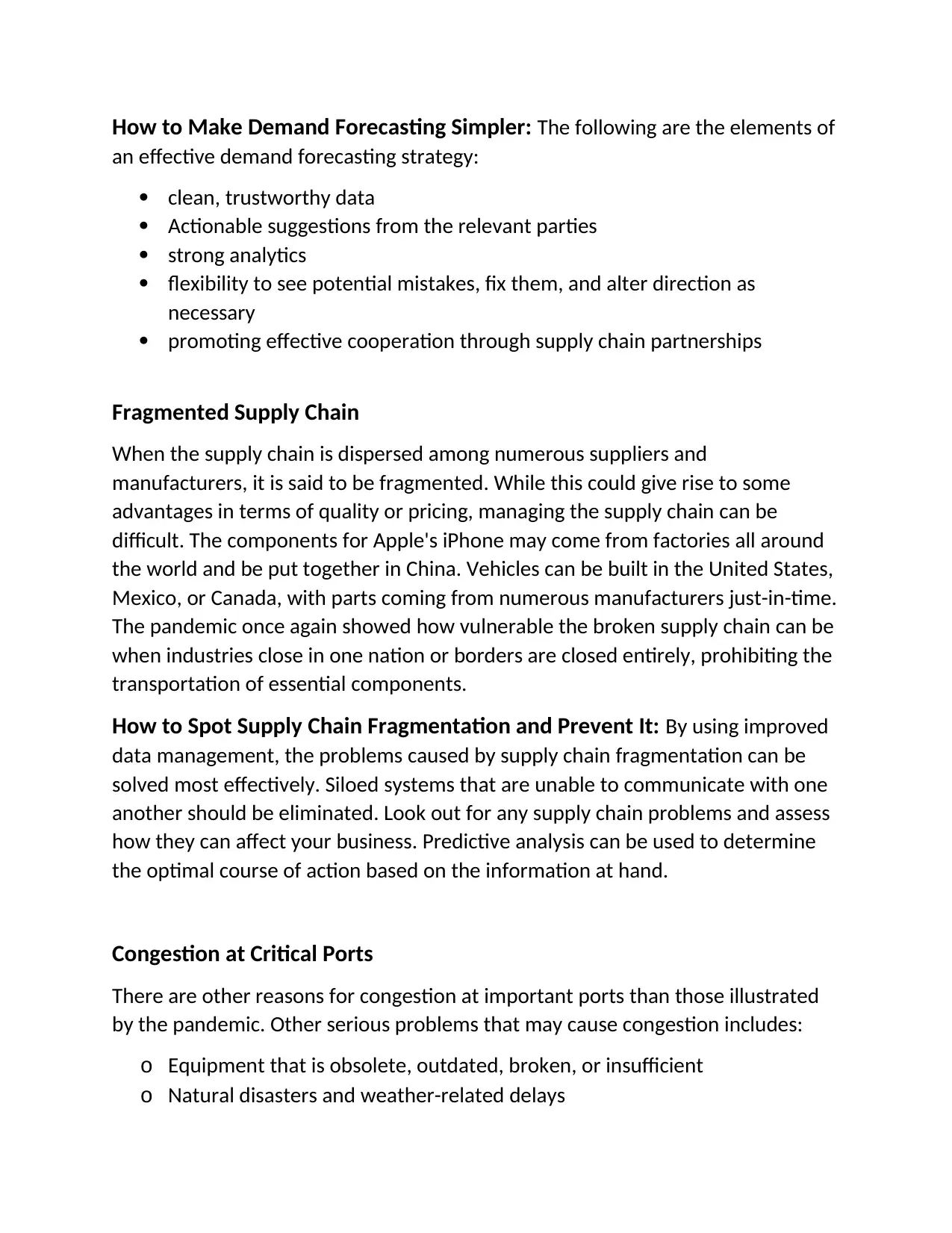
How to Make Demand Forecasting Simpler: The following are the elements of
an effective demand forecasting strategy:
clean, trustworthy data
Actionable suggestions from the relevant parties
strong analytics
flexibility to see potential mistakes, fix them, and alter direction as
necessary
promoting effective cooperation through supply chain partnerships
Fragmented Supply Chain
When the supply chain is dispersed among numerous suppliers and
manufacturers, it is said to be fragmented. While this could give rise to some
advantages in terms of quality or pricing, managing the supply chain can be
difficult. The components for Apple's iPhone may come from factories all around
the world and be put together in China. Vehicles can be built in the United States,
Mexico, or Canada, with parts coming from numerous manufacturers just-in-time.
The pandemic once again showed how vulnerable the broken supply chain can be
when industries close in one nation or borders are closed entirely, prohibiting the
transportation of essential components.
How to Spot Supply Chain Fragmentation and Prevent It: By using improved
data management, the problems caused by supply chain fragmentation can be
solved most effectively. Siloed systems that are unable to communicate with one
another should be eliminated. Look out for any supply chain problems and assess
how they can affect your business. Predictive analysis can be used to determine
the optimal course of action based on the information at hand.
Congestion at Critical Ports
There are other reasons for congestion at important ports than those illustrated
by the pandemic. Other serious problems that may cause congestion includes:
o Equipment that is obsolete, outdated, broken, or insufficient
o Natural disasters and weather-related delays
an effective demand forecasting strategy:
clean, trustworthy data
Actionable suggestions from the relevant parties
strong analytics
flexibility to see potential mistakes, fix them, and alter direction as
necessary
promoting effective cooperation through supply chain partnerships
Fragmented Supply Chain
When the supply chain is dispersed among numerous suppliers and
manufacturers, it is said to be fragmented. While this could give rise to some
advantages in terms of quality or pricing, managing the supply chain can be
difficult. The components for Apple's iPhone may come from factories all around
the world and be put together in China. Vehicles can be built in the United States,
Mexico, or Canada, with parts coming from numerous manufacturers just-in-time.
The pandemic once again showed how vulnerable the broken supply chain can be
when industries close in one nation or borders are closed entirely, prohibiting the
transportation of essential components.
How to Spot Supply Chain Fragmentation and Prevent It: By using improved
data management, the problems caused by supply chain fragmentation can be
solved most effectively. Siloed systems that are unable to communicate with one
another should be eliminated. Look out for any supply chain problems and assess
how they can affect your business. Predictive analysis can be used to determine
the optimal course of action based on the information at hand.
Congestion at Critical Ports
There are other reasons for congestion at important ports than those illustrated
by the pandemic. Other serious problems that may cause congestion includes:
o Equipment that is obsolete, outdated, broken, or insufficient
o Natural disasters and weather-related delays
⊘ This is a preview!⊘
Do you want full access?
Subscribe today to unlock all pages.

Trusted by 1+ million students worldwide
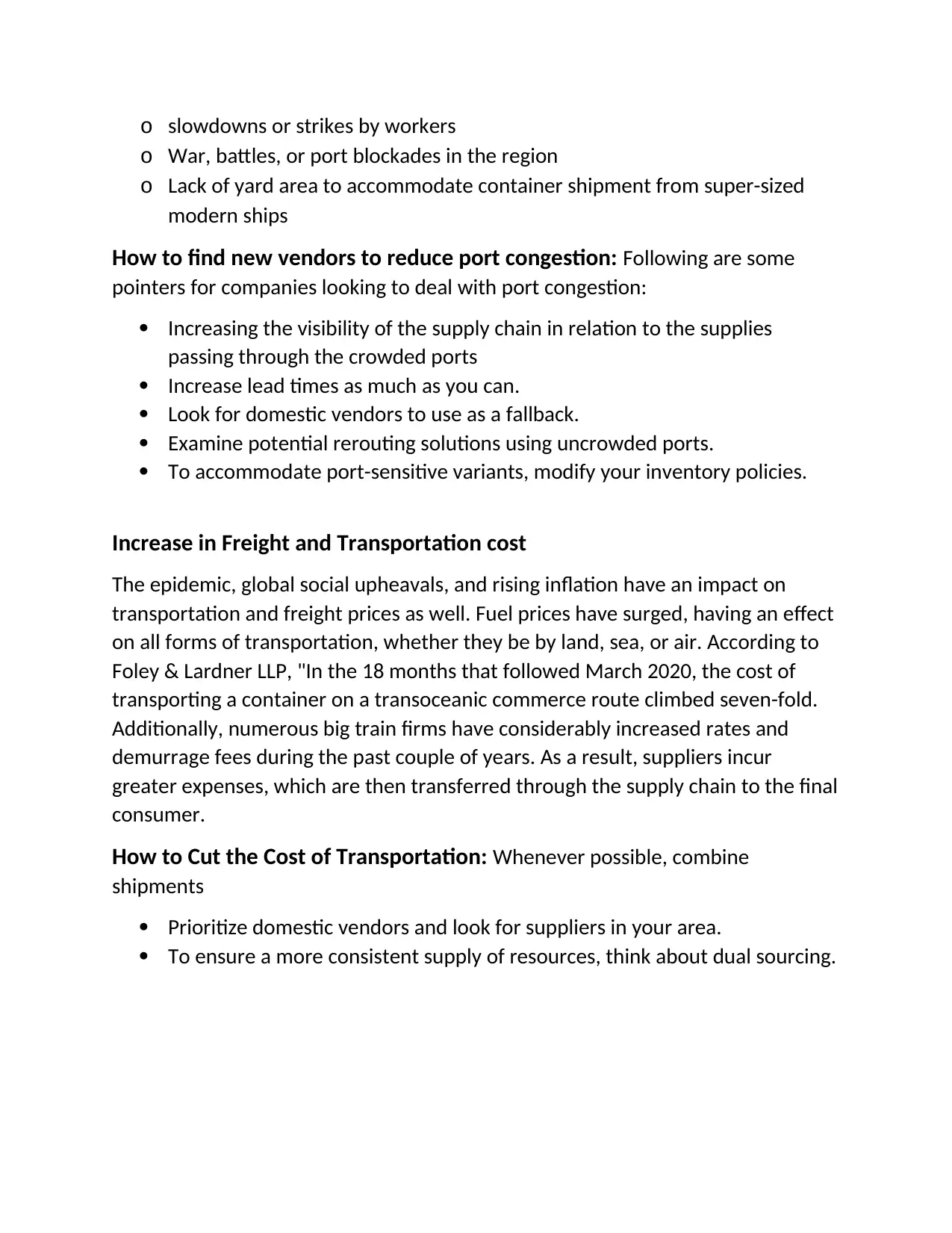
o slowdowns or strikes by workers
o War, battles, or port blockades in the region
o Lack of yard area to accommodate container shipment from super-sized
modern ships
How to find new vendors to reduce port congestion: Following are some
pointers for companies looking to deal with port congestion:
Increasing the visibility of the supply chain in relation to the supplies
passing through the crowded ports
Increase lead times as much as you can.
Look for domestic vendors to use as a fallback.
Examine potential rerouting solutions using uncrowded ports.
To accommodate port-sensitive variants, modify your inventory policies.
Increase in Freight and Transportation cost
The epidemic, global social upheavals, and rising inflation have an impact on
transportation and freight prices as well. Fuel prices have surged, having an effect
on all forms of transportation, whether they be by land, sea, or air. According to
Foley & Lardner LLP, "In the 18 months that followed March 2020, the cost of
transporting a container on a transoceanic commerce route climbed seven-fold.
Additionally, numerous big train firms have considerably increased rates and
demurrage fees during the past couple of years. As a result, suppliers incur
greater expenses, which are then transferred through the supply chain to the final
consumer.
How to Cut the Cost of Transportation: Whenever possible, combine
shipments
Prioritize domestic vendors and look for suppliers in your area.
To ensure a more consistent supply of resources, think about dual sourcing.
o War, battles, or port blockades in the region
o Lack of yard area to accommodate container shipment from super-sized
modern ships
How to find new vendors to reduce port congestion: Following are some
pointers for companies looking to deal with port congestion:
Increasing the visibility of the supply chain in relation to the supplies
passing through the crowded ports
Increase lead times as much as you can.
Look for domestic vendors to use as a fallback.
Examine potential rerouting solutions using uncrowded ports.
To accommodate port-sensitive variants, modify your inventory policies.
Increase in Freight and Transportation cost
The epidemic, global social upheavals, and rising inflation have an impact on
transportation and freight prices as well. Fuel prices have surged, having an effect
on all forms of transportation, whether they be by land, sea, or air. According to
Foley & Lardner LLP, "In the 18 months that followed March 2020, the cost of
transporting a container on a transoceanic commerce route climbed seven-fold.
Additionally, numerous big train firms have considerably increased rates and
demurrage fees during the past couple of years. As a result, suppliers incur
greater expenses, which are then transferred through the supply chain to the final
consumer.
How to Cut the Cost of Transportation: Whenever possible, combine
shipments
Prioritize domestic vendors and look for suppliers in your area.
To ensure a more consistent supply of resources, think about dual sourcing.
Paraphrase This Document
Need a fresh take? Get an instant paraphrase of this document with our AI Paraphraser
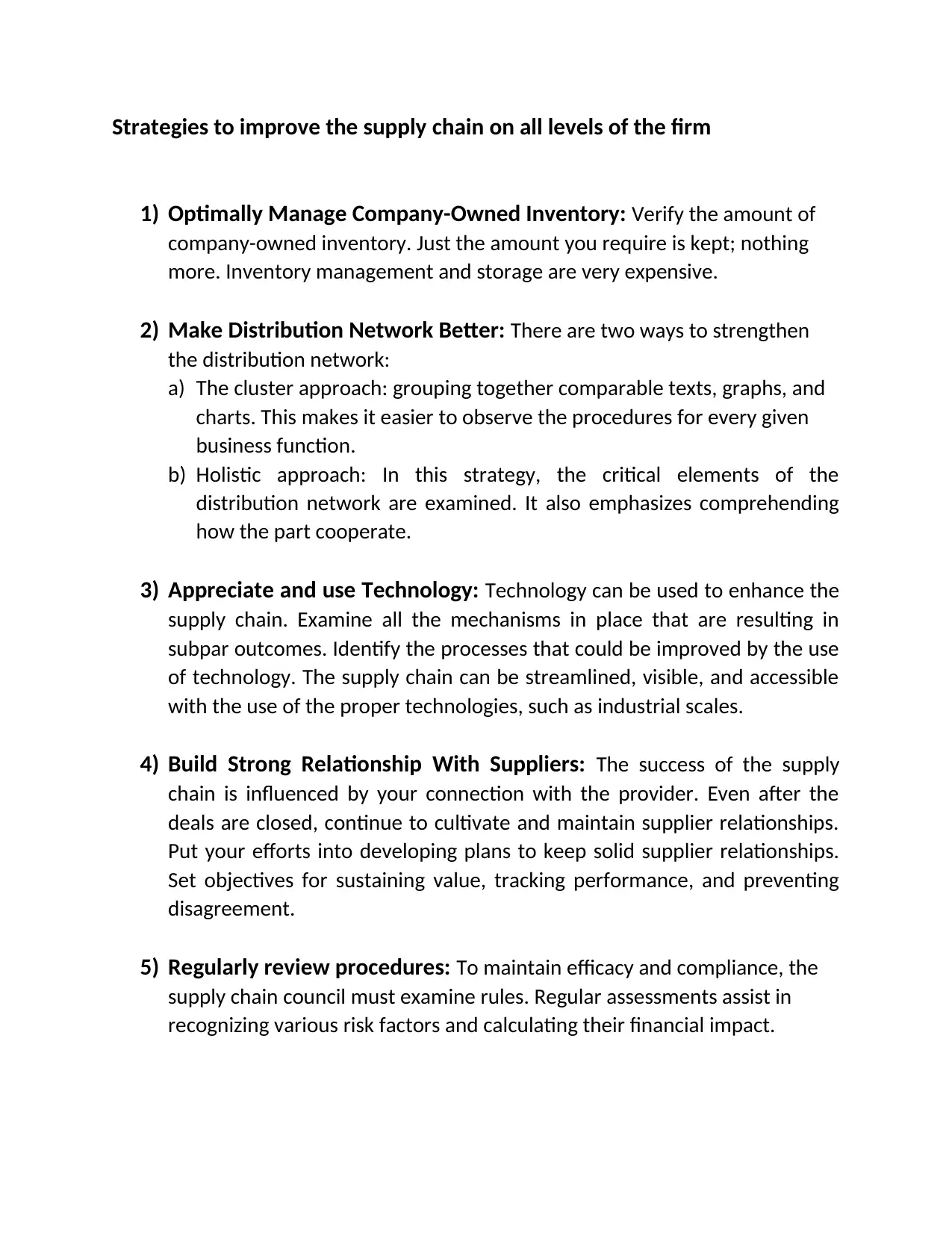
Strategies to improve the supply chain on all levels of the firm
1) Optimally Manage Company-Owned Inventory: Verify the amount of
company-owned inventory. Just the amount you require is kept; nothing
more. Inventory management and storage are very expensive.
2) Make Distribution Network Better: There are two ways to strengthen
the distribution network:
a) The cluster approach: grouping together comparable texts, graphs, and
charts. This makes it easier to observe the procedures for every given
business function.
b) Holistic approach: In this strategy, the critical elements of the
distribution network are examined. It also emphasizes comprehending
how the part cooperate.
3) Appreciate and use Technology: Technology can be used to enhance the
supply chain. Examine all the mechanisms in place that are resulting in
subpar outcomes. Identify the processes that could be improved by the use
of technology. The supply chain can be streamlined, visible, and accessible
with the use of the proper technologies, such as industrial scales.
4) Build Strong Relationship With Suppliers: The success of the supply
chain is influenced by your connection with the provider. Even after the
deals are closed, continue to cultivate and maintain supplier relationships.
Put your efforts into developing plans to keep solid supplier relationships.
Set objectives for sustaining value, tracking performance, and preventing
disagreement.
5) Regularly review procedures: To maintain efficacy and compliance, the
supply chain council must examine rules. Regular assessments assist in
recognizing various risk factors and calculating their financial impact.
1) Optimally Manage Company-Owned Inventory: Verify the amount of
company-owned inventory. Just the amount you require is kept; nothing
more. Inventory management and storage are very expensive.
2) Make Distribution Network Better: There are two ways to strengthen
the distribution network:
a) The cluster approach: grouping together comparable texts, graphs, and
charts. This makes it easier to observe the procedures for every given
business function.
b) Holistic approach: In this strategy, the critical elements of the
distribution network are examined. It also emphasizes comprehending
how the part cooperate.
3) Appreciate and use Technology: Technology can be used to enhance the
supply chain. Examine all the mechanisms in place that are resulting in
subpar outcomes. Identify the processes that could be improved by the use
of technology. The supply chain can be streamlined, visible, and accessible
with the use of the proper technologies, such as industrial scales.
4) Build Strong Relationship With Suppliers: The success of the supply
chain is influenced by your connection with the provider. Even after the
deals are closed, continue to cultivate and maintain supplier relationships.
Put your efforts into developing plans to keep solid supplier relationships.
Set objectives for sustaining value, tracking performance, and preventing
disagreement.
5) Regularly review procedures: To maintain efficacy and compliance, the
supply chain council must examine rules. Regular assessments assist in
recognizing various risk factors and calculating their financial impact.
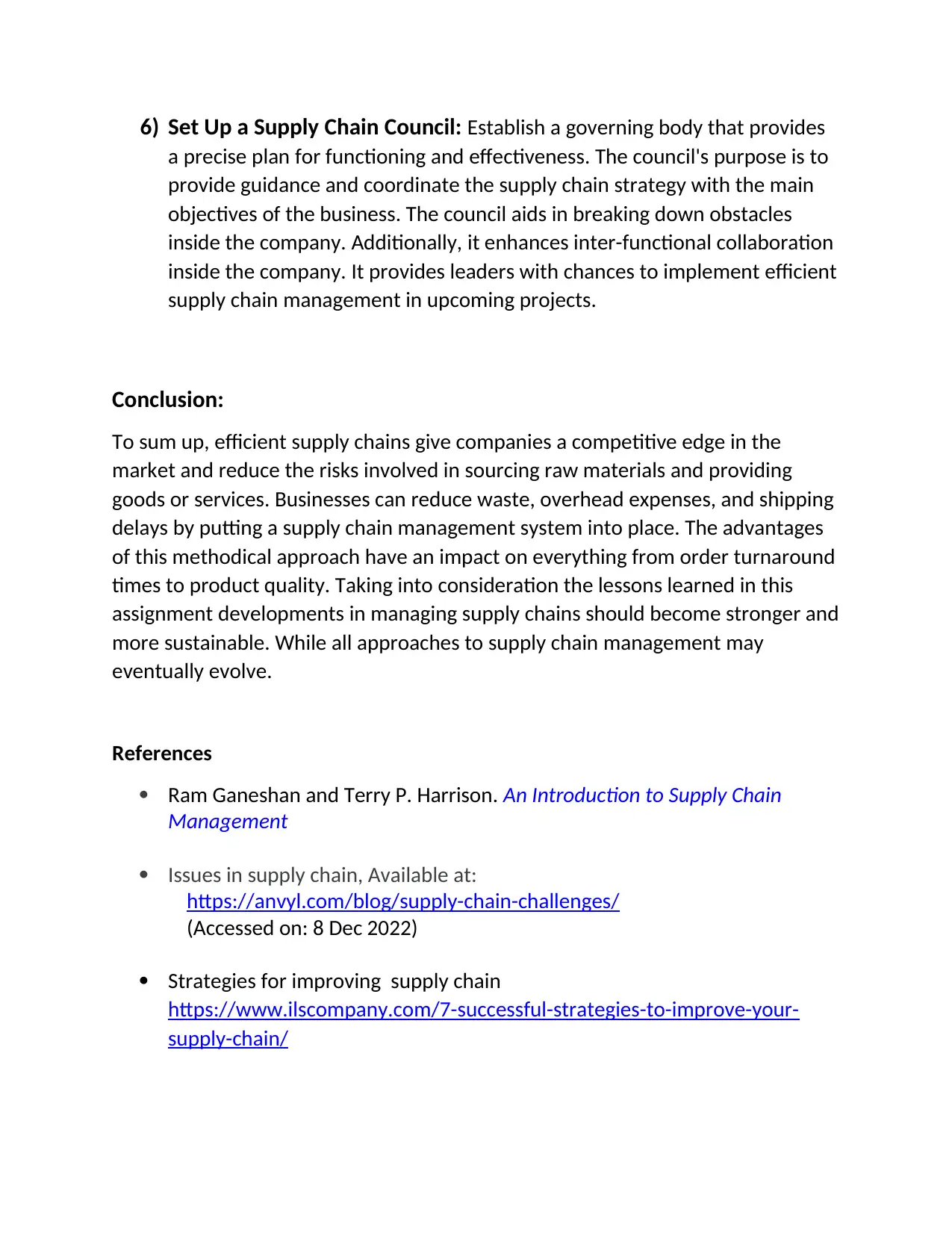
6) Set Up a Supply Chain Council: Establish a governing body that provides
a precise plan for functioning and effectiveness. The council's purpose is to
provide guidance and coordinate the supply chain strategy with the main
objectives of the business. The council aids in breaking down obstacles
inside the company. Additionally, it enhances inter-functional collaboration
inside the company. It provides leaders with chances to implement efficient
supply chain management in upcoming projects.
Conclusion:
To sum up, efficient supply chains give companies a competitive edge in the
market and reduce the risks involved in sourcing raw materials and providing
goods or services. Businesses can reduce waste, overhead expenses, and shipping
delays by putting a supply chain management system into place. The advantages
of this methodical approach have an impact on everything from order turnaround
times to product quality. Taking into consideration the lessons learned in this
assignment developments in managing supply chains should become stronger and
more sustainable. While all approaches to supply chain management may
eventually evolve.
References
Ram Ganeshan and Terry P. Harrison. An Introduction to Supply Chain
Management
Issues in supply chain, Available at:
https://anvyl.com/blog/supply-chain-challenges/
(Accessed on: 8 Dec 2022)
Strategies for improving supply chain
https://www.ilscompany.com/7-successful-strategies-to-improve-your-
supply-chain/
a precise plan for functioning and effectiveness. The council's purpose is to
provide guidance and coordinate the supply chain strategy with the main
objectives of the business. The council aids in breaking down obstacles
inside the company. Additionally, it enhances inter-functional collaboration
inside the company. It provides leaders with chances to implement efficient
supply chain management in upcoming projects.
Conclusion:
To sum up, efficient supply chains give companies a competitive edge in the
market and reduce the risks involved in sourcing raw materials and providing
goods or services. Businesses can reduce waste, overhead expenses, and shipping
delays by putting a supply chain management system into place. The advantages
of this methodical approach have an impact on everything from order turnaround
times to product quality. Taking into consideration the lessons learned in this
assignment developments in managing supply chains should become stronger and
more sustainable. While all approaches to supply chain management may
eventually evolve.
References
Ram Ganeshan and Terry P. Harrison. An Introduction to Supply Chain
Management
Issues in supply chain, Available at:
https://anvyl.com/blog/supply-chain-challenges/
(Accessed on: 8 Dec 2022)
Strategies for improving supply chain
https://www.ilscompany.com/7-successful-strategies-to-improve-your-
supply-chain/
⊘ This is a preview!⊘
Do you want full access?
Subscribe today to unlock all pages.

Trusted by 1+ million students worldwide

David Simchi Levi, Philip kaminsky, and Edith Simchi Levi. Designing and
Managing the Supply Chain: Concepts, Strategies
Managing the Supply Chain: Concepts, Strategies
1 out of 7
Related Documents
Your All-in-One AI-Powered Toolkit for Academic Success.
+13062052269
info@desklib.com
Available 24*7 on WhatsApp / Email
![[object Object]](/_next/static/media/star-bottom.7253800d.svg)
Unlock your academic potential
Copyright © 2020–2025 A2Z Services. All Rights Reserved. Developed and managed by ZUCOL.





